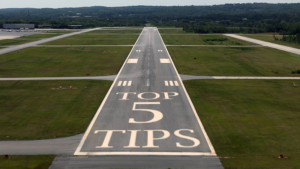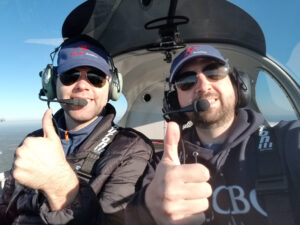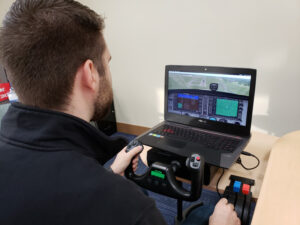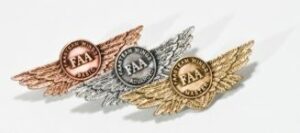 It is often said that experience is the best teacher. But learning from personal experience often takes time and results in inefficiencies along the way. That is why it is important to glean wisdom from others who have already accomplished the goals you are striving after.
It is often said that experience is the best teacher. But learning from personal experience often takes time and results in inefficiencies along the way. That is why it is important to glean wisdom from others who have already accomplished the goals you are striving after.
Many new flight students know they want to earn a pilot certificate, but are not aware of the best way to proceed with training. The instructors at Gleim Aviation asked themselves the question “What would I change if I could do my flight training over again?” and have shared their experiences of what did and what didn’t work during their training. Here are five tips that our instructors want you to keep in mind as you progress through your flight training:
1. Train with your end goal in mind.
Before you begin training, it is vital that you sit down and consider why you want to earn a pilot certificate. Your reason will affect every decision you make along the way, from what school you attend to how often you’ll fly.
- If you plan on becoming a flight instructor, start developing lesson plans early, even during private pilot training. Not only will this help you when it is time for flight instructor training, but by learning to teach concepts you will develop a greater understanding of the material than you would otherwise.
- If your goal is to become an airline pilot, start preparing like a professional from the very beginning.
- If you want a pilot certificate for business, personal, or recreational use, work with your flight school to adapt your training to the specific type of flying you will be doing.

2. Find the right flight instructor.
Perhaps more than any other factor, flight instructors have a direct impact on your success as a student. It is the instructor’s job to create a learning environment that is conducive to the student accomplishing his or her goals, and some instructors do a better job at this than others. It is important to choose a flight instructor with whom you will feel comfortable, and if you feel like your instructor is not up to par, don’t be afraid to find another one! Too many students waste time and money on instructors who are only focused on advancing their own career instead of teaching.
So how do you find the right instructor? There is no easy answer, but there is a simple step you can take to help ensure you hire a quality instructor: interview potential flight instructors.
- Visit as many flight schools as you can in your area.
- Talk to flight instructors about their training program and ask questions.
- Treat this process like an interview where the potential instructor is auditioning for you to hire them.
- Have a set of questions prepared that you can ask the instructors you interview. A sample list of interview questions can be found in Step 4 of Gleim’s Private Pilot Steps to Success.
- Compare all of the responses and find the instructor that is the best fit for you.
We’ve touched on what happens when your student-instructor relationship is less than ideal and how to choose a flight school. Check out these articles to learn more:
Flight Training With Frustrating Students And Instructors
Choosing Your Flight School: Part 61 Vs. 141 Training
3. Finish ground school and the knowledge test early in the process.
Many students dive into flight training head first with little thought given to ground school, let alone the knowledge test that is required before the practical test. It is a much better strategy to work through ground school and pass the knowledge test early, perhaps even before you begin flying. Although learning how to fly an airplane is the ultimate goal, there is a lot of work that must go into training on the ground first. By completing the ground school first, you will be equipped with the knowledge you need to be successful once you begin flight training. In addition, you will not have the added stress and time commitment of preparing for the knowledge test, which will free up time to better prepare for each flight lesson.
4. Prepare on the ground before you fly.
Preparation on the ground before a flight lesson may be even more important than the flight itself. Too often, students arrive at the airport for a lesson and wait for the instructor to tell them what they will be doing that day. It should not be this way! As the student, you need to be proactive, especially if your instructor does not give you regular assignments to study on your own. If you want to gain the maximum benefit from each and every flight lesson, thoroughly review the syllabus ahead of time and be familiar with the lesson objectives before you arrive at the airport.
 One of the best ways to prepare is by using a simulator to practice the lesson tasks beforehand. You don’t need a $100,000 simulator to do this, although many flight schools have one available. A simple desktop simulator like X-Plane on your computer at home can help you build proficiency. Use your flight training syllabus and fly your next lesson in the simulator before flying it in the aircraft. Practice the principles you learned during ground school to reinforce the concepts. This way, you will not waste time in the airplane learning concepts and procedures that you could have learned on the ground. This is the key to minimizing flight time in training. Whether you use a simulator or simply a chair, you must prepare for every lesson before you fly.
One of the best ways to prepare is by using a simulator to practice the lesson tasks beforehand. You don’t need a $100,000 simulator to do this, although many flight schools have one available. A simple desktop simulator like X-Plane on your computer at home can help you build proficiency. Use your flight training syllabus and fly your next lesson in the simulator before flying it in the aircraft. Practice the principles you learned during ground school to reinforce the concepts. This way, you will not waste time in the airplane learning concepts and procedures that you could have learned on the ground. This is the key to minimizing flight time in training. Whether you use a simulator or simply a chair, you must prepare for every lesson before you fly.
5. Don’t stop training.
It is an exciting time when you finish your training and earn a private pilot certificate. Months or years of work culminate into one moment, and it is a huge accomplishment. Many students intend to continue earning higher certificates and ratings, but life has a way of halting plans. Changes in location, job, or family can cause training goals to fall to the wayside. If possible, keep flying and begin working toward an instrument rating as soon as you can. Earning an instrument rating will increase your proficiency as a pilot and will save you time and money by reducing the amount you need to relearn.
Regardless of where you are in training, it is never too late to shake off the rust and get back into flying. Even if it has been a long time since you have flown, or if you have moved and don’t know anyone at the airport, do not let fear stop you from accomplishing your goals. The aviation community has always been warm and welcoming, with people who want to see you accomplish your training goals. Give your local flight school a call and ask to schedule a flight or tour the facilities. You may take a “re-discovery flight” and surprise yourself with how well it all comes back to you.
Even if you fly regularly, there is a saying that a good pilot never stops learning. Instead of just meeting with an instructor every two years to complete a flight review, try completing WINGS phases. Also known as the “Pilot Proficiency Program,” completing WINGS phases will not only meet your flight review requirements, it will help ensure that you develop a safety mindset and make training and proficiency a priority. Anybody with a pilot certificate, even a student pilot, can start working on WINGS phases. As an added incentive, a $10,000 sweepstakes is available to participants who complete WINGS phases.
 Ultimately, flight training is a lifelong process and pilots should learn something new from every flight. Whether you just received your new student pilot certificate or have been flying for decades, these tips can help you accomplish your flying goals. Always keep your end goal in mind, surround yourself with the right people, take initiative and work ahead, prepare for every situation, and never stop flying!
Ultimately, flight training is a lifelong process and pilots should learn something new from every flight. Whether you just received your new student pilot certificate or have been flying for decades, these tips can help you accomplish your flying goals. Always keep your end goal in mind, surround yourself with the right people, take initiative and work ahead, prepare for every situation, and never stop flying!
Written by Karl Winters, Gleim Aviation Editor and Instructor

